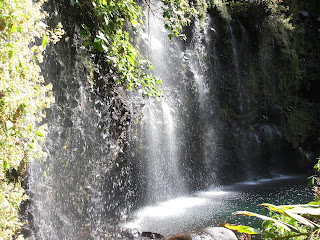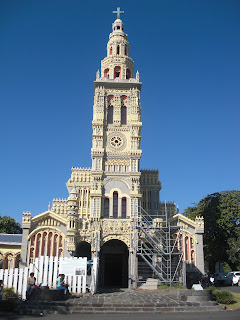
The trip down the East coast of Africa is a challenging
one. Richards Bay to Durban is 100nm and
is an overnight sail. This is not too
difficult as one only needs a 24hr window of favorable weather. The next leg, Durban to East London, is the
most difficult as it is 250nm with absolutely no safe harbors in between. A
favorable forecast of at least 3 days is imperative. Since the forecasts are only
accurate for 3 days, at the most, there is an element of chance involved. The Agulhas current can reach 6 knots near
East London and with any southerly wind over 15 knots, conditions can become
dangerous very quickly. As luck would have it, there was a 3 day forecast for light
winds 4 days after reaching Durban so I made use of it. The conventional wisdom is, “if you get a window you must not
hesitate”. During the trip I had only 6
hours of southerly wind @ 12-15 knots but even that made the seas very rough. I
don’t even want to think about what it would be like in 30 knots. I received
another forecast on the satellite phone enroute and decided to continue past
East London to Port Elizabeth. I was there for only 12 hours and decided to
keep moving toward Cape Town. The Agulhas current had now spread out across the
Agulhas Bank and is no longer a factor. Now all I had to worry about was the infamous ”Cape
of Storms” Cape Agulhas itself. Port Elizabeth to Mossel Bay was not too bad
save the last 8 hours. With only the smallest mainsail set, the
knotmeter (an instrument that measures
the boats actual speed through the water), not the GPS, read 10.2 knots… pretty
wild. Mossel Bay port control reported 40 knots +.
After 4 very rolly days at the yacht club marina I received a forecast with
a 24 hour window of light winds at the Cape. Again I decided to give it a go.
At 1057 local time on the 22
nd of October I passed Cape Agulhas and
from the Indian Ocean into the Atlantic. I was able to make a 30 degree right
turn and for the first time since leaving Thursday Island at the top of
Australia, the wind, current, waves and swell were
all behind me. The remainder of the sail up the West coast was very
pleasant and took me past The Cape of
Good Hope. There is a funneling effect
of the SE wind off Table Mountain and into Table Bay which is why one should
plan a dawn arrival as it should be much calmer. Not for my dawn arrival. If
someone would have told me that the highest winds to date for the entire
circumnavigation would be
inside the
breakwater in Cape Town, I would have said, have another drink pal… 47 gusts to
55!! Holy crap.
I am snug in the V&A (Victoria & Alfred) Waterfront
Marina right in the middle of Cape Town.. Awesome.
P.S. Most of the other cruisers are stuck in Richards Bay
waiting for weather.


















































